Effects of Heterogeneous Sulfated Acid Photocatalysts and Irradiation of Ultraviolet Light on the Chemical Conversion and Characteristics of Antifreeze from Bioglycerol
Abstract
1. Introduction
2. Materials and Methods
2.1. Preparation for Heterogeneous Strong Acid Photocatalysts and Acetic Acid-Based Glycerides
2.1.1. Preparation of TiO2/SO42− Solid-State Strong Acid Photocatalyst
2.1.2. Preparation of Acetic Acid-Based Glycerides
2.1.3. After-Treatment Procedures for the Prepared Glycerine Acetate Product
2.2. Analysis of Characteristics of Solid-State Strong Acid Photocatalysts and Glycerine Acetate
2.2.1. TiO2/SO42− Heterogeneous Strong Acid Photocatalyst Characterization
2.2.2. Characteristics Analysis of Glycerine Acetate
3. Results and Discussion
3.1. Characterization of the Heterogeneous Strong Acid Photocatalyst
3.1.1. Structural Analysis of the TiO2/SO42− Photocatalyst
3.1.2. Analysis of Infrared Spectroscopy for the TiO2/SO42− Photocatalyst
3.1.3. Thermogravimetric Analysis of the TiO2/SO42− Photocatalyst
3.2. Effects of Molar Ratio on Product Compositions Converted from Glycerol
3.2.1. Effect of Irradiated UV Light and Molar Ratio on the Conversion Ratio of Glycerol
3.2.2. Effects of UV Light Irradiation and Molar Ratio on Triacylglycerol Production
3.2.3. Effects of Irradiated UV Light and Molar Ratio on Diacylglycerol Production
3.2.4. Effects of Irradiated UV Light and Molar Ratio on Monoacylglycerol Production
4. Conclusions
- The TiO2/SO42− heterogeneous strong acid photocatalyst prepared in this experiment did not affect the crystalline phase of TiO2 itself under the presence of SO42−, nor did it affect the symbolic wavelength of the crystalline structure of TiO2 of the sharp titanium type. Hence, similar X-ray intensity structures between the catalysts of TiO2 and TiO2/SO42− were observed.
- The presence of bonding wavelengths of sulfur oxide in the infrared spectral frequency between 900 and 1300 cm−1 was confirmed using Fourier-transform infrared spectroscopy (FTIR). The experimental observance also confirmed that preparing the heterogeneous strong acid photocatalysts was effective in sintering SO42− to its carrier and bonding it with TiO2.
- In comparison with the TiO2 catalyst analyzed via thermogravimetric analysis, the TiO2/SO42− catalyst was found to have significant weight loss at 540 °C because of the decomposition of SO42−.
- The glycerol conversion ratio reached 98.65% under the reaction conditions of a molar ratio of acetic acid/glycerol equal to 8, a reaction temperature of 120 °C, a UV light wavelength of 365 nm, and a reaction time of 10 h. The derived product of glycerine acetate under the above conversion conditions appeared to have superior antifreeze properties, including the lowest freezing point, which was −46.36 °C. In addition, the content of triacylglycerol in the product under the above reaction conditions was the highest, 40.41%.
- When the molar ratio of acetic acid/glycerol was increased to 9, the glycerol conversion rate and the formation of glycerol triacetate in the product decreased to 98.03% and 34.63%, respectively, under the application of UV-light irradiation on the catalyst.
- The highest formation ratios of diacylglycerol and monoacylglycerol, which were 56.04% and 13.67%, respectively, appeared at molar ratios of acetic acid/glycerol equal to 5 and 9, respectively. In addition, the formation ratio of monoacylglycerol at a molar ratio equal to 9 converged for the cases with and without UV light irradiation.
- The effects of UV light irradiation on the TiO2/SO42− photocatalyst for the esterification reaction of glycerol with acetic acid caused higher triacylglycerol and diacylglycerol formation and lower monoacylglycerol formation than the reactions occurring without UV light irradiation.
Author Contributions
Funding
Institutional Review Board Statement
Informed Consent Statement
Data Availability Statement
Acknowledgments
Conflicts of Interest
References
- Braga, E.R.; Neto, G.J.; Braga, R.R.; Pontes, L.A. Optimized conditions for the design and operation of a vacuum distillation column for the purification of crude glycerol from biodiesel production. Biofuel. Bioprod. Biorefin. 2023, 17, 1203–1220. [Google Scholar] [CrossRef]
- Samuel, O.D.; Aigba, P.A.; Tran, T.K.; Fayaz, H.; Pastore, C.; Der, O.; Mustafa, A. Comparison of the techno-economic and environmental assessment of hydrodynamic cavitation and mechanical stirring reactors for the production of sustainable hevea Brasiliensis ethyl ester. Sustainability 2023, 15, 16287. [Google Scholar] [CrossRef]
- Raj, J.V.A.; Kumar, R.P.; Vijayakumar, B.; Gnansounou, E.; Bharathiraja, B. Modelling and process optimization for biodiesel production from Nannochloropsis salina using artificial neural network. Bioresour. Technol. 2021, 329, 124872. [Google Scholar] [CrossRef]
- Maina, S.; Dheskali, E.; Papapostolou, H.; Castro, A.M.d.; Guimaraes Freire, D.M.; Nychas, G.J.; Papanikolaou, S.; Kookos, I.K.; Koutinas, A. Bioprocess development for 2, 3-butanediol production from crude glycerol and conceptual process design for aqueous conversion into methyl ethyl ketone. ACS Sustain. Chem. Eng. 2021, 9, 8692–8705. [Google Scholar] [CrossRef]
- Kumar, L.R.; Yellapu, S.K.; Tyagi, R.D.; Drogui, P. Cost, energy and GHG emission assessment for microbial biodiesel production through valorization of municipal sludge and crude glycerol. Bioresour. Technol. 2020, 297, 122404. [Google Scholar] [CrossRef]
- Alisson Dias da Silva, R.; Ana Luíza Freitas, F.; Antônio Ésio, B.; Rita Maria de Brito, A.; Luiz Antônio Magalhães, P. Market Prospecting and Assessment of the Economic Potential of Glycerol from Biodiesel; IntechOpen: London, UK, 2020; pp. 185–198. [Google Scholar]
- Moklis, M.H.; Cheng, S.; Cross, J.S. Current and Future Trends for Crude Glycerol Upgrading to High Value-Added Products. Sustainability 2023, 15, 2979. [Google Scholar] [CrossRef]
- Lin, C.-Y. The influences of promising feedstock variability on advanced biofuel production: A review. J. Mar. Sci. Technol. 2022, 29, 714–730. [Google Scholar] [CrossRef]
- Jaiswal, S.; Pradhan, G.; Sharma, Y.C. Green and facile synthesis of glycerol carbonate from bio-glycerol assisted by lithium titanate: A robust and selective heterogeneous catalyst. J. Taiwan Inst. Chem. Eng. 2021, 128, 388–399. [Google Scholar] [CrossRef]
- Lima, P.J.M.; da Silva, R.M.; Neto, C.A.C.G.; Gomes e Silva, N.C.; Souza, J.E.d.S.; Nunes, Y.L.; Sousa dos Santos, J.C. An overview on the conversion of glycerol to value-added industrial products via chemical and biochemical routes. Biotechnol. Appl. Biochem. 2022, 69, 2794–2818. [Google Scholar] [CrossRef]
- de Sousa Junior, P.G.; do Nascimento Camara, A.G.; Oliveira, A.R.T.; de Castro Lima, G.; Lima, G.V.; Coutinho, L.P.; Alexandre, J.Y.N.H.; Serafim, L.F.; de Mattos, M.C.; de Kássio Monteiro, N.V. Optimization and theoretical analysis of lipase-catalyzed enzymatic esterification of glycerol for efficient glycerides synthesis. Biochem. Eng. J. 2023, 198, 109033. [Google Scholar] [CrossRef]
- Dizoğlu, G.; Sert, E. Fuel additive synthesis by acetylation of glycerol using activated carbon/UiO-66 composite materials. Fuel 2020, 281, 118584. [Google Scholar] [CrossRef]
- Cheong, B.E.; Yu, D.; Martinez-Seidel, F.; Ho, W.W.H.; Rupasinghe, T.W.; Dolferus, R.; Roessner, U. The Effect of Cold Stress on the Root-Specific Lipidome of Two Wheat Varieties with Contrasting Cold Tolerance. Plants 2022, 11, 1364. [Google Scholar] [CrossRef]
- Rigo, D.; Polidoro, D.; Marcuzzo, L.; Perosa, A.; Selva, M. Isopropenyl Acetate for the Continuous-Flow Synthesis of Triacetin, Solketal Acetate, and Allyl Acetate from Pure or Crude Glycerol. ACS Sustain. Chem. Eng. 2023. [Google Scholar] [CrossRef]
- Salas-Papayanopolos, H.; Morales-Cepeda, A.B.; Wood-Adams, P.; Sanchez, S.; Lafleur, P.G.; Vazquez, H.P. Crystallization effect of poly (L-lactic acid)/silver nanocomposites blends, on barrier and mechanical properties using glyceryl triacetate as plasticizer. Polym. Bull. 2023, 80, 5273–5290. [Google Scholar] [CrossRef]
- Mufrodi, Z.; Astuti, E.; Budiman, A.; Prasetya, A. Utilization of glycerol from biodiesel industry by-product into several higher value products. In Valorisation of Agro-Industrial Residues; Springer: Berlin/Heidelberg, Germany, 2020; Volume 2, pp. 145–172. ISBN 978-3-030-39207-9. [Google Scholar]
- Mandari, V.; Devarai, S.K. Biodiesel Production Using Homogeneous, Heterogeneous, and Enzyme Catalysts via Transesterification and Esterification Reactions: A Critical Review. Bioenergy Res. 2022, 15, 935–961. [Google Scholar] [CrossRef] [PubMed]
- Pant, K.K.; Gupta, S.K.; Ahmad, E. Catalysis for Clean Energy and Environmental Sustainability; Springer: Berlin/Heidelberg, Germany, 2021; Volume 1, pp. 185–208. [Google Scholar]
- Yu, X.; Williams, C.T. Recent advances in the applications of mesoporous silica in heterogeneous catalysis. Catal. Sci. Technol. 2022, 12, 5765–5794. [Google Scholar] [CrossRef]
- Castro-Hoyos, A.M.; Rojas Manzano, M.A.; Maury-Ramírez, A. Challenges and opportunities of using titanium dioxide photocatalysis on cement-based materials. Coatings 2022, 12, 968. [Google Scholar] [CrossRef]
- Ijaz, M.; Zafar, M. Titanium dioxide nanostructures as efficient photocatalyst: Progress, challenges and perspective. Int. J. Energy Res. 2021, 45, 3569–3589. [Google Scholar] [CrossRef]
- Khan, Z.; Javed, F.; Shamair, Z.; Hafeez, A.; Fazal, T.; Aslam, A.; Rehman, F. Current developments in esterification reaction: A review on process and parameters. J. Ind. Eng. Chem. 2021, 103, 80–101. [Google Scholar] [CrossRef]
- Shera Farisya, M.R.; Irmawati, R.; Shafizah, I.N.; Taufiq-Yap, Y.H.; Muhamad, E.N.; Lee, S.L.; Salamun, N. Assessment on the effect of sulfuric acid concentration on physicochemical properties of sulfated-titania catalyst and glycerol acetylation performance. Catalysts 2021, 11, 1542. [Google Scholar] [CrossRef]
- de Oliveira, C.P.M.; Lage, A.L.A.; da Silva Martins, D.C.; Mohallem, N.D.S.; Viana, M.M. High surface area TiO2 nanoparticles: Impact of carboxylporphyrin sensitizers in the photocatalytic activity. Surf. Interfaces 2020, 21, 100774. [Google Scholar] [CrossRef]
- Nguyen, T.L.; Dinh Quoc, V.; Nguyen, T.L.; Le, T.T.T.; Dinh, T.K.; Nguyen, V.T.; Nguyen, P.H. Visible-light-driven SO42−/TiO2 photocatalyst synthesized from binh dinh (Vietnam) Ilmenite ore for rhodamine B degradation. J. Nanomater. 2021, 2021, 1–13. [Google Scholar] [CrossRef]
- Skipitari, M.; Kalaitzopoulou, E.; Papadea, P.; Varemmenou, A.; Gavriil, V.E.; Sarantopoulou, E.; Cefalas, A.C.; Tsakas, S.; Rosmaraki, E.; Margiolaki, I. Titanium dioxide nanoparticle-based hydroxyl and superoxide radical production for oxidative stress biological simulations. J. Photochem. Photobiol. A Chem. 2023, 435, 114290. [Google Scholar] [CrossRef]
- Wanniarachchi, W.C.P.; Arunasalam, T.; Ravirajan, P.; Velauthapillai, D.; Vajeeston, P. Hybrid Functional Study on Electronic and Optical Properties of the Dopants in Anatase TiO2. ACS Omega 2023, 8, 42275–42289. [Google Scholar] [CrossRef] [PubMed]
- Geetha, S.; Thangamani, A.; Valliappan, R.; Vedanayaki, S.; Ganapathi, A. Sulfated titania (TiO2–SO42−) as an efficient and reusable solid acid catalyst for the multi-component synthesis of highly functionalized piperidines. Chem. Data Collect. 2020, 30, 100565. [Google Scholar] [CrossRef]
- Mou, R.; Wang, X.; Wang, Z.; Zhang, D.; Yin, Z.; Lv, Y.; Wei, Z. Synthesis of fuel bioadditive by esterification of glycerol with acetic acid over hydrophobic polymer-based solid acid. Fuel 2021, 302, 121175. [Google Scholar] [CrossRef]
- Nda-Umar, U.I.; Ramli, I.B.; Muhamad, E.N.; Azri, N.; Amadi, U.F.; Taufiq-Yap, Y.H. Influence of heterogeneous catalysts and reaction parameters on the acetylation of glycerol to acetin: A review. Appl. Sci. 2020, 10, 7155. [Google Scholar] [CrossRef]
- Jadhav, H.; Annapure, U. Greener route for intensified synthesis of Tricaprylin using Amberlyst-15. J. Chem. Sci. 2021, 133, 1–7. [Google Scholar] [CrossRef]
- da Silva, M.J.; Lopes, N.P.G.; Rodrigues, A.A. Biodiesel Additives Synthesis Using Solid Heteropolyacid Catalysts. Energies 2023, 16, 1332. [Google Scholar] [CrossRef]
- Pang, C.; Han, R.; Su, Y.; Zheng, Y.; Peng, M.; Liu, Q. Effect of the acid site in the catalytic degradation of volatile organic compounds: A review. Chem. Eng. J. 2023, 454, 140125. [Google Scholar] [CrossRef]
- Caballero, K.V.; Guerrero-Amaya, H.; Baldovino-Medrano, V.G. Revisiting glycerol esterification with acetic acid over Amberlyst-35 via statistically designed experiments: Overcoming transport limitations. Chem. Eng. Sci. 2019, 207, 91–104. [Google Scholar] [CrossRef]
- Sedghi, R.; Shahbeik, H.; Rastegari, H.; Rafiee, S.; Peng, W.; Nizami, A.S.; Gupta, V.K.; Chen, W.H.; Lam, S.S.; Pan, J. Turning biodiesel glycerol into oxygenated fuel additives and their effects on the behavior of internal combustion engines: A comprehensive systematic review. Renew. Sustain. Energy Rev. 2022, 167, 112805. [Google Scholar] [CrossRef]
- Faruque, M.O.; Razzak, S.A.; Hossain, M.M. Application of heterogeneous catalysts for biodiesel production from microalgal oil—A review. Catalysts 2020, 10, 1025. [Google Scholar] [CrossRef]
- Banu, I.; Bumbac, G.; Bombos, D.; Velea, S.; Gălan, A.M.; Bozga, G. Glycerol acetylation with acetic acid over Purolite CT-275. Product yields and process kinetics. Renew. Energ. 2020, 148, 548–557. [Google Scholar] [CrossRef]
- Cai, Z.; Zhuang, X.; Yang, X.; Huang, F.; Wang, Y.; Li, Y. Litsea cubeba kernel oil as a promising new medium-chain saturated fatty acid feedstock for biolubricant base oil synthesis. Ind. Crops Prod. 2021, 167, 113564. [Google Scholar] [CrossRef]
- Peter, A.; Nicula, C.; Mihaly Cozmuta, A.; Drazic, G.; Peñas, A.; Silvi, S.; Mihaly Cozmuta, L. Polylactic Acid-Based Film Modified with Nano-Ag-Graphene-TiO2: New Film versus Recycled Film. Adv. Polym. Technol. 2023. [Google Scholar] [CrossRef]
- Özyiğit, B.; Sayilganlar, E.; Akbay, E. Photocatalytic esterification of acetic acid with methanol over metal-exchanged phosphotungstate. J. Photochem. Photobiol. A Chem. 2024, 447, 115280. [Google Scholar] [CrossRef]
- Verma, P.; Wanchoo, R.K.; Toor, A.P. Plasmonic silver nanoparticles decorated surface functionalized Zirconium doped quantum dots-for enhanced photochemical synthesis of lactic acid esters. Chem. Eng. J. 2022, 430, 132550. [Google Scholar] [CrossRef]
- Wang, S.; Pu, J.; Wu, J.; Liu, H.; Xu, H.; Li, X.; Wang, H. SO42−/ZrO2 as a solid acid for the esterification of palmitic acid with methanol: Effects of the calcination time and recycle method. ACS Omega 2020, 5, 30139–30147. [Google Scholar] [CrossRef]
- Shihab, I.A.; Muhammed, M.Y.; Alheety, M.A.; Nuaman, H.A.; Karadag, A. Rapid ultrasound-assisted synthesis, characterization, DFT, molecular docking, and anticancer activity of palladium and zinc complexes with 2, 6-dimethoxybenzoic acid: A comprehensive study. J. Mol. Struct. 2023, 1294, 136259. [Google Scholar] [CrossRef]
- Nivetha, N.; Thangamani, A.; Velmathi, S. Sulfated titania (TiO2-SO42−) as an efficient catalyst for organic synthesis: Overarching review from 2000 to 2021. ChemistrySelect 2022, 7, e202104505. [Google Scholar] [CrossRef]
- Arslan-Alaton, I.; Koba-Ucun, O.; Turkten, N.; Sora, I.N.; Bekbolet, M. More about Persulfate-Assisted Ferrilanthanide-Mediated Photocatalysis of Textile Industry Dye Reactive Black 5: Surface Properties and Structural Assessment. Water 2023, 15, 906. [Google Scholar] [CrossRef]
- Li, C.F.; Zhao, J.W.; Xie, L.j.; Wu, J.Q.; Li, G.R. Water adsorption and dissociation promoted by Co*-/NC*-biactive sites of metallic Co/N-doped carbon hybrids for efficient hydrogen evolution. Appl. Catal. B Environ. 2021, 282, 119463. [Google Scholar] [CrossRef]
- Vargas-Villanueva, S.; Torres-Ceron, D.A.; Amaya-Roncancio, S.; Arellano-Ramírez, I.; Riva, J.S.; Restrepo-Parra, E. Study of the incorporation of S in TiO2/SO42− Coatings produced by PEO process through XPS and DFT. Appl. Surf. Sci. 2022, 599, 153811. [Google Scholar] [CrossRef]
- Wong, W.Y.; Lim, S.; Pang, Y.L.; Chen, W.H.; Lam, M.K.; Tan, I.S. Synthesis of glycerol-free fatty acid methyl ester using interesterification reaction based on solid acid carbon catalyst derived from low-cost biomass wastes. Int. J. Energy Res. 2022, 46, 147–162. [Google Scholar] [CrossRef]
- Mufrodi, Z.; Astuti, E.; Syamsiro, M.; Sutiman; Purwono, S. Triacetin synthesis as bio-additive from glycerol using homogeneous and heterogeneous catalysts. Key Eng. Mater. 2020, 849, 90–95. [Google Scholar] [CrossRef]
- Banerjee, M.; Panjikar, P.C.; Bhutia, Z.T.; Bhosle, A.A.; Chatterjee, A. Micellar nanoreactors for organic transformations with a focus on “dehydration” reactions in water: A decade update. Tetrahedron 2021, 88, 132142. [Google Scholar] [CrossRef]
- Ding, L.; Li, M.; Zhao, Y.; Zhang, H.; Shang, J.; Zhong, J.; Sheng, H.; Chen, C.; Zhao, J. The vital role of surface Brönsted acid/base sites for the photocatalytic formation of free ·OH radicals. Appl. Catal. B Environ. 2020, 266, 118634. [Google Scholar] [CrossRef]
- Qiu, X.; Xie, X.; Meesapyodsuk, D. Molecular mechanisms for biosynthesis and assembly of nutritionally important very long chain polyunsaturated fatty acids in microorganisms. Prog. Lipid Res. 2020, 79, 101047. [Google Scholar] [CrossRef]
- Combescot, M.; Amand, T.; Shiau, S.Y. Ab initio quantum approach to electron hole exchange for semiconductors hosting Wannier excitons. Phys. Rev. B 2023, 107, 115206. [Google Scholar] [CrossRef]
- Wang, S.; Liu, G.; Cheng, W. Comparative evaluation of four free radical scavengers for the inhibition of individual glycidyl ester formation in rice bran oil determined by UPLC-MS/MS. Int. J. Food Sci. Technol. 2021, 56, 2983–2991. [Google Scholar] [CrossRef]
- Ferreira, G.F.; Pessoa, J.G.B.; Pinto, L.F.R.; Maciel Filho, R.; Fregolente, L.V. Mono-and diglyceride production from microalgae: Challenges and prospects of high-value emulsifiers. Trends Food Sci. Technol. 2021, 118, 589–600. [Google Scholar] [CrossRef]
- Chen, L.; Wang, L.; Wan, Y.; Zhang, Y.; Qi, Z.; Wu, X.; Xu, H. Acetylene and diacetylene functionalized covalent triazine frameworks as metal-free photocatalysts for hydrogen peroxide production: A new two-electron water oxidation pathway. Adv. Mater. 2020, 32, 1904433. [Google Scholar] [CrossRef] [PubMed]

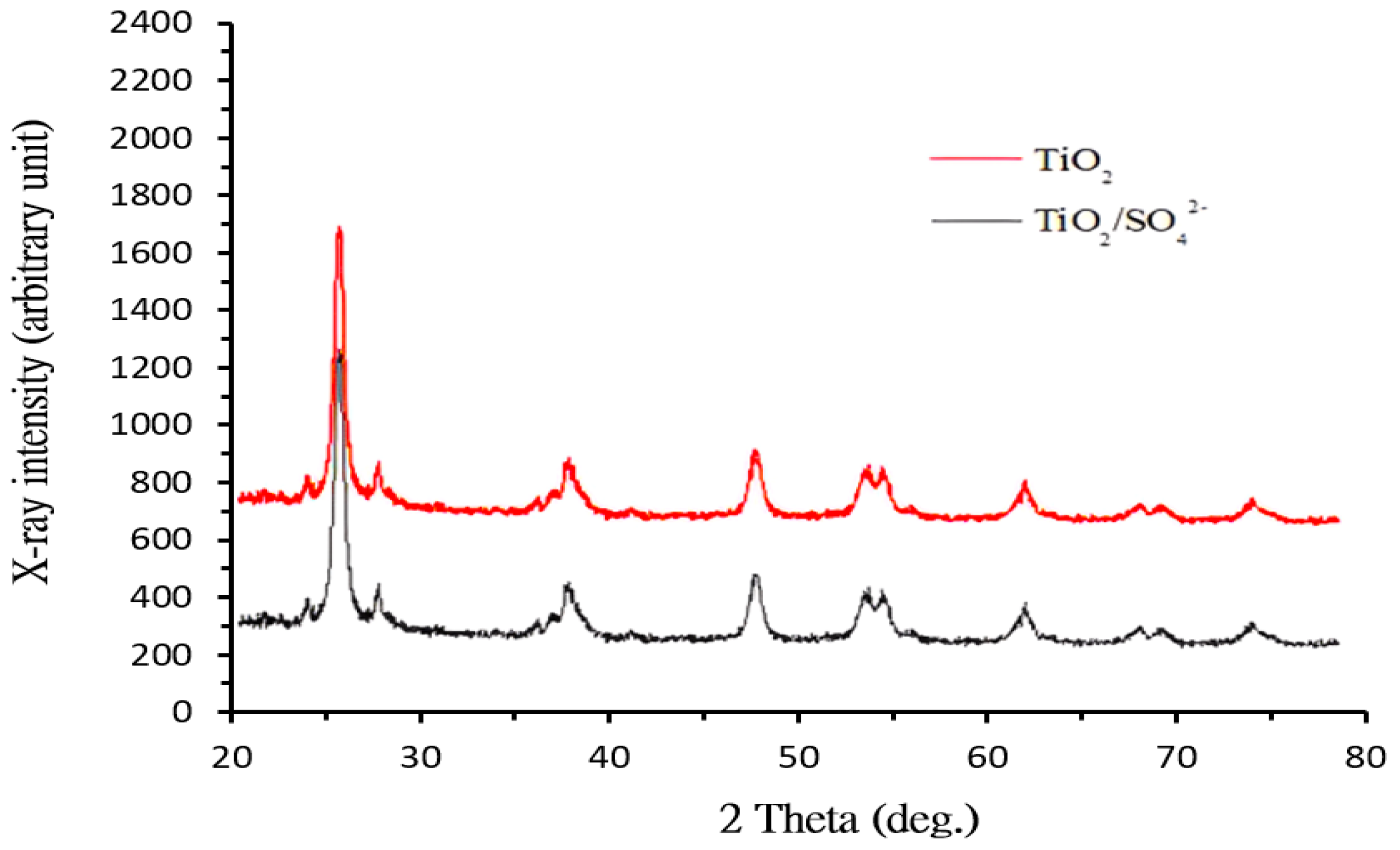
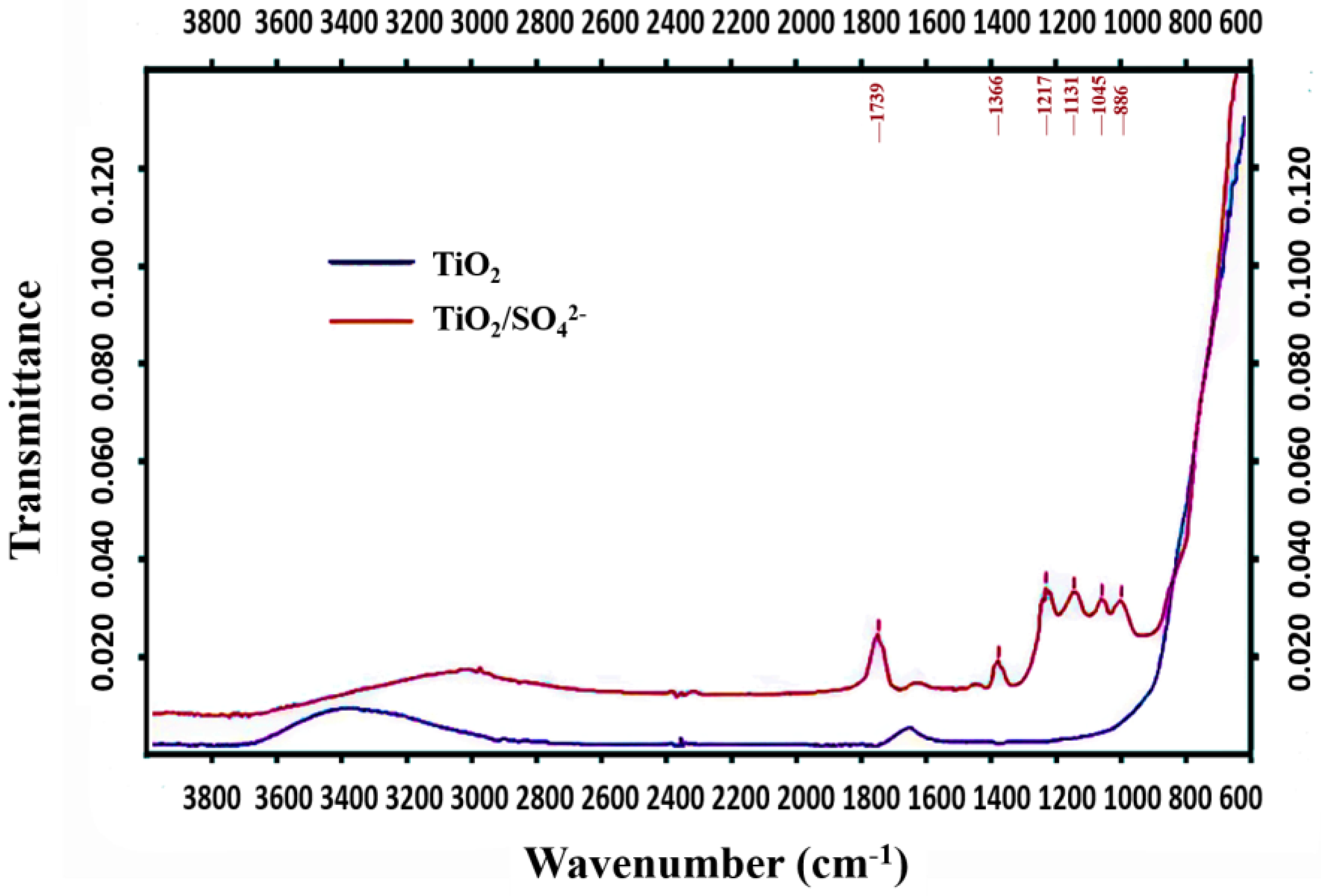

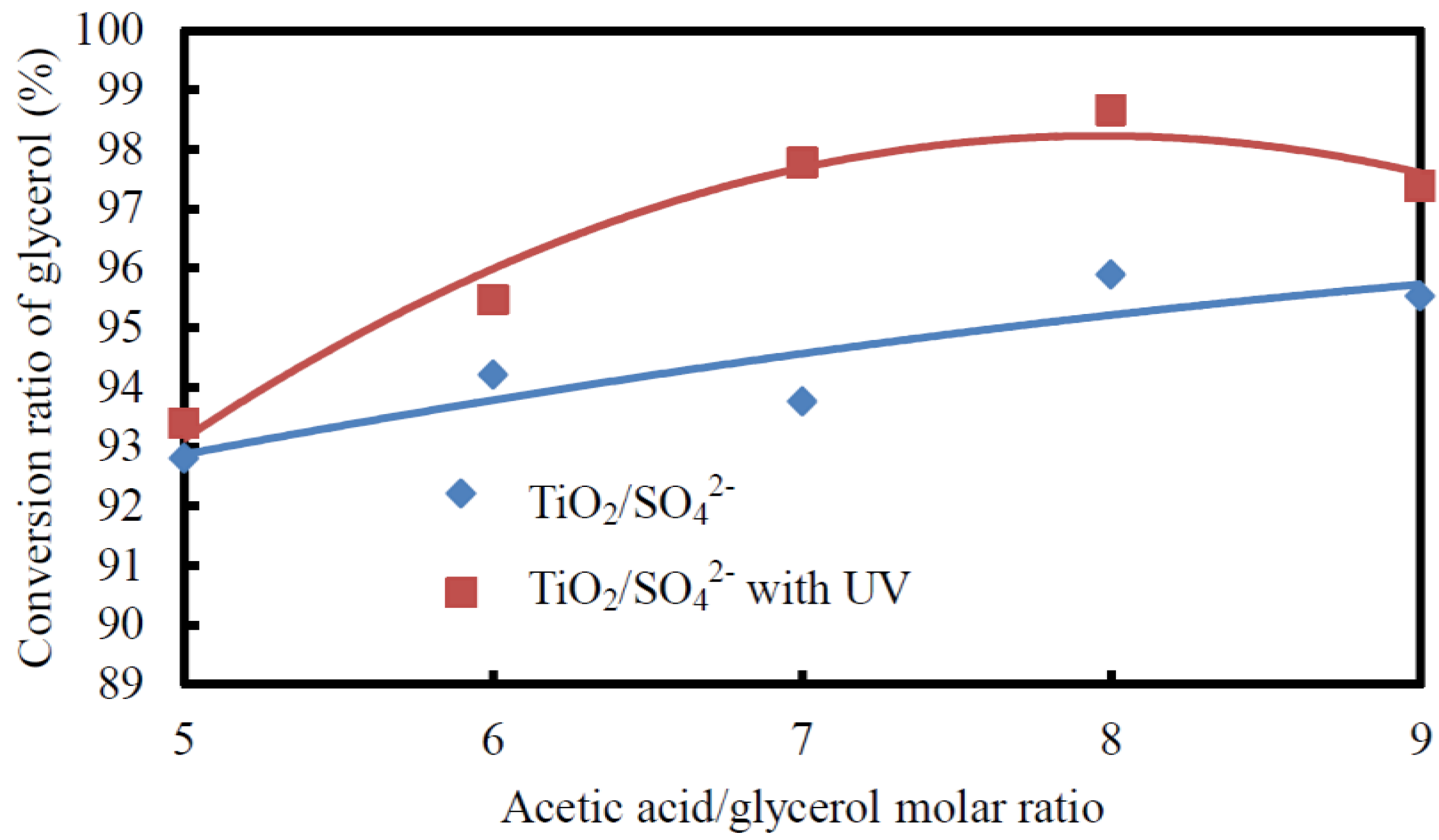
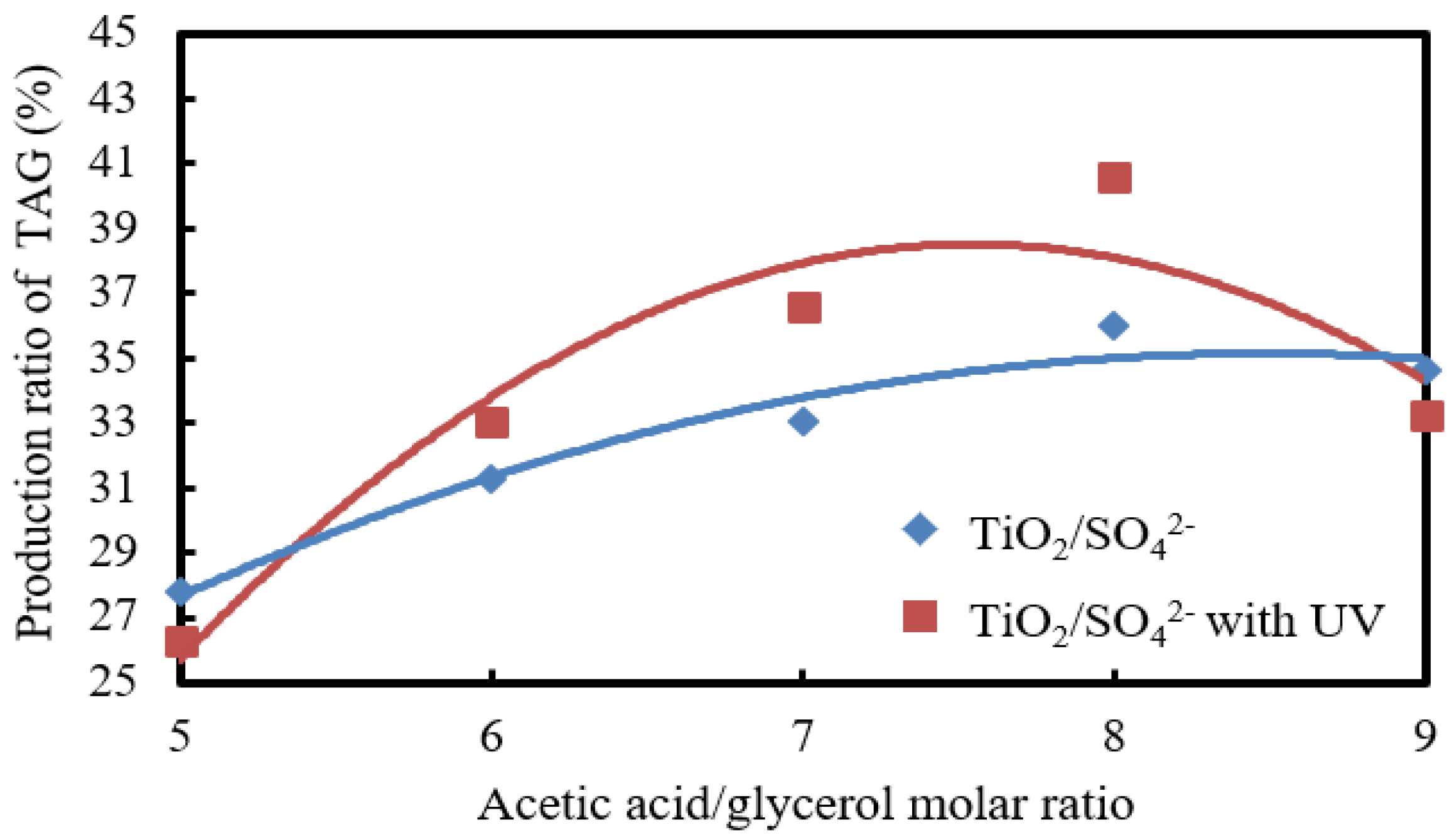
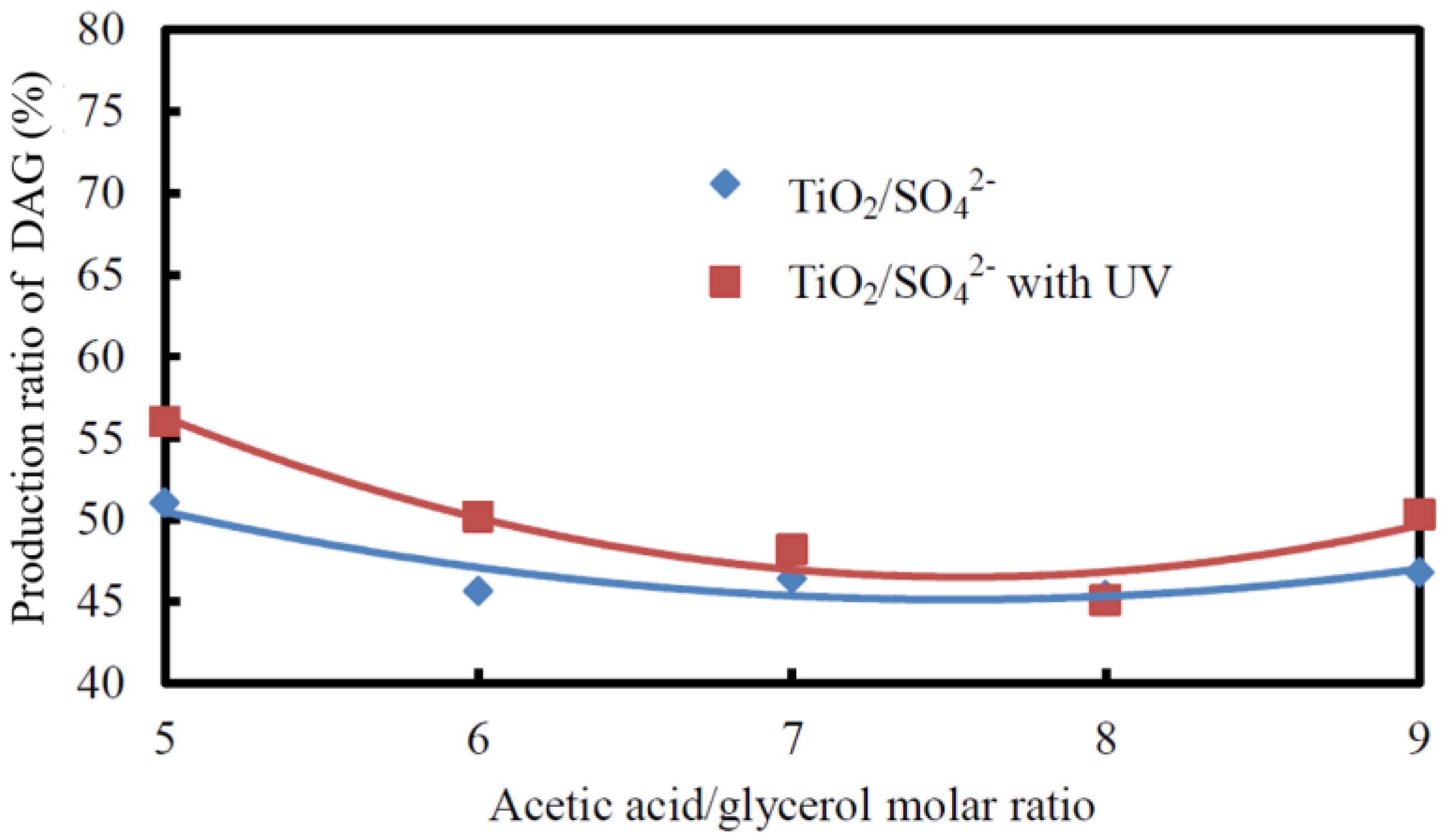

Disclaimer/Publisher’s Note: The statements, opinions and data contained in all publications are solely those of the individual author(s) and contributor(s) and not of MDPI and/or the editor(s). MDPI and/or the editor(s) disclaim responsibility for any injury to people or property resulting from any ideas, methods, instructions or products referred to in the content. |
© 2024 by the authors. Licensee MDPI, Basel, Switzerland. This article is an open access article distributed under the terms and conditions of the Creative Commons Attribution (CC BY) license (https://creativecommons.org/licenses/by/4.0/).
Share and Cite
Lin, C.-Y.; Chen, Y.-C. Effects of Heterogeneous Sulfated Acid Photocatalysts and Irradiation of Ultraviolet Light on the Chemical Conversion and Characteristics of Antifreeze from Bioglycerol. Processes 2024, 12, 383. https://doi.org/10.3390/pr12020383
Lin C-Y, Chen Y-C. Effects of Heterogeneous Sulfated Acid Photocatalysts and Irradiation of Ultraviolet Light on the Chemical Conversion and Characteristics of Antifreeze from Bioglycerol. Processes. 2024; 12(2):383. https://doi.org/10.3390/pr12020383
Chicago/Turabian StyleLin, Cherng-Yuan, and Yun-Chih Chen. 2024. "Effects of Heterogeneous Sulfated Acid Photocatalysts and Irradiation of Ultraviolet Light on the Chemical Conversion and Characteristics of Antifreeze from Bioglycerol" Processes 12, no. 2: 383. https://doi.org/10.3390/pr12020383
APA StyleLin, C.-Y., & Chen, Y.-C. (2024). Effects of Heterogeneous Sulfated Acid Photocatalysts and Irradiation of Ultraviolet Light on the Chemical Conversion and Characteristics of Antifreeze from Bioglycerol. Processes, 12(2), 383. https://doi.org/10.3390/pr12020383







